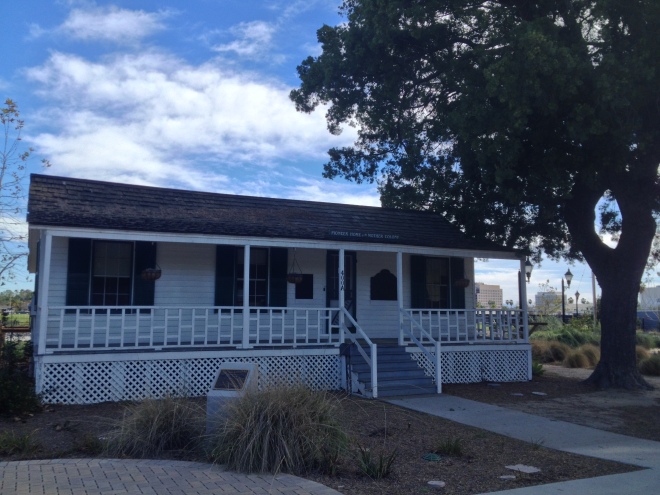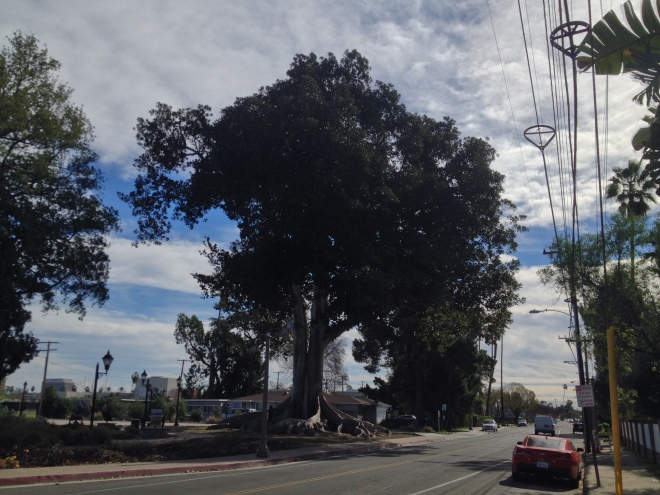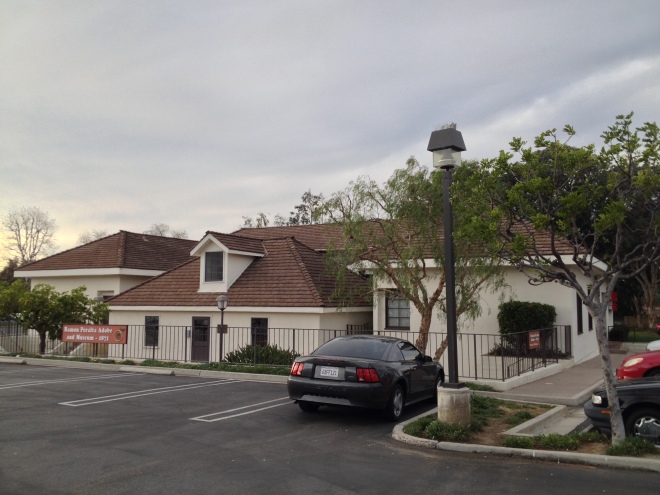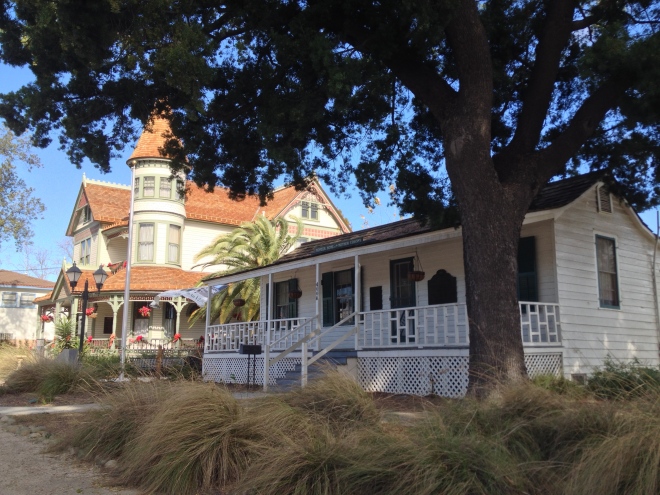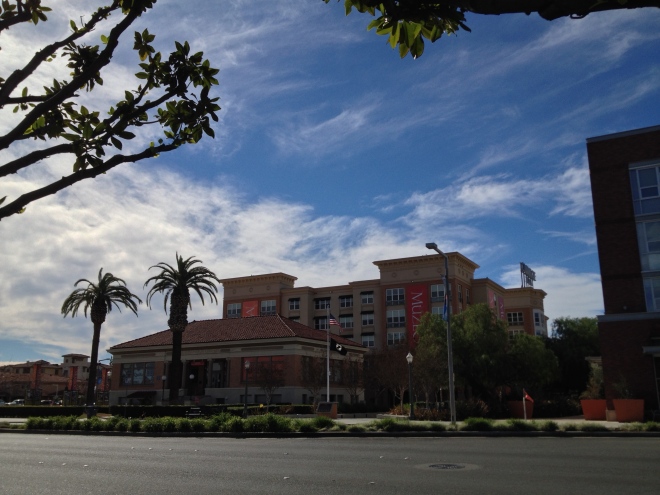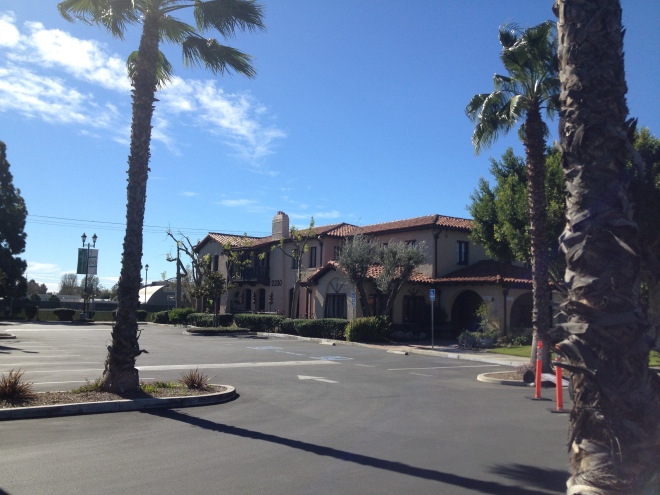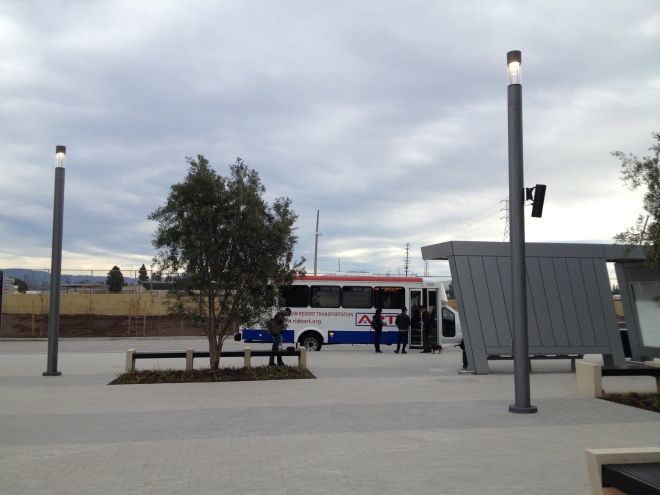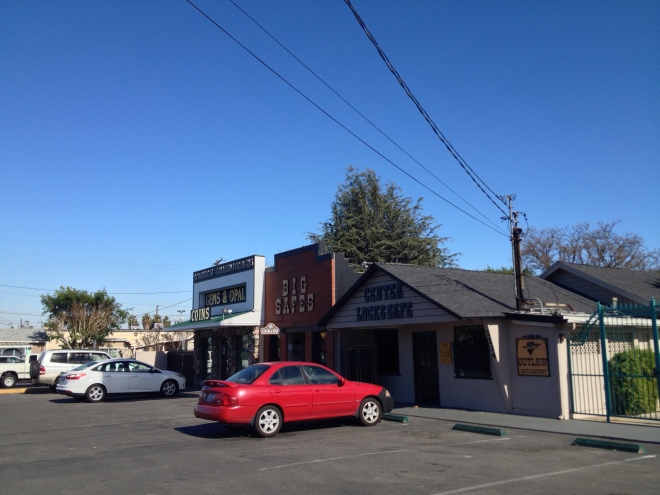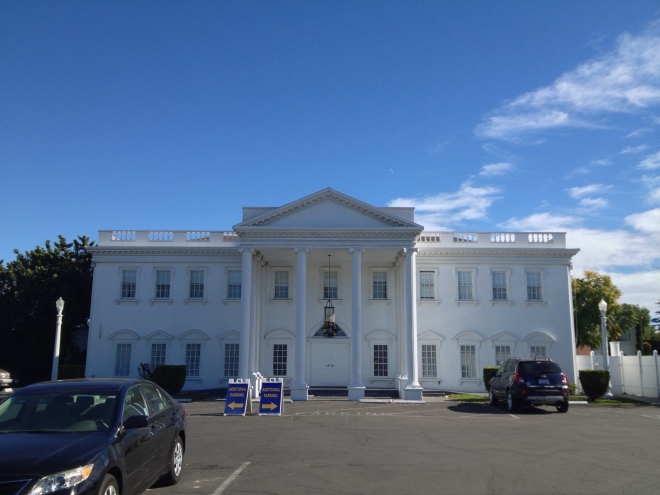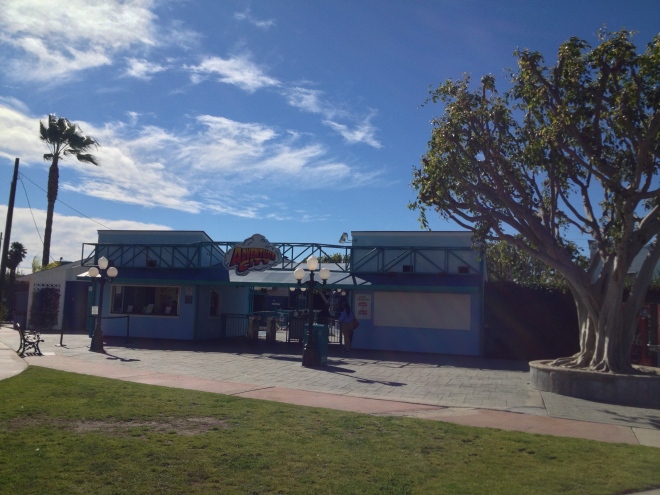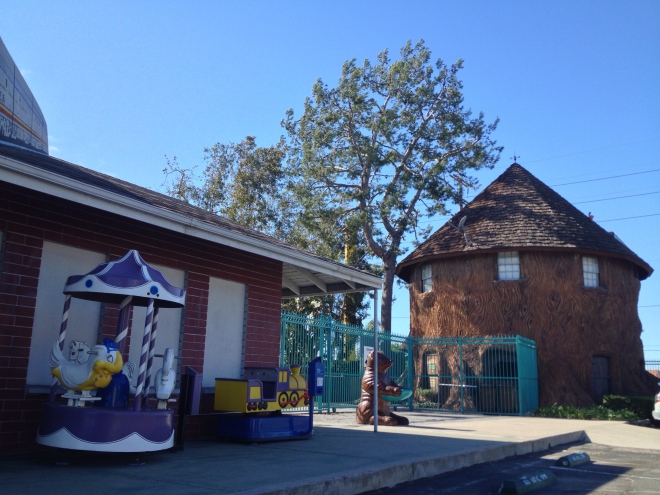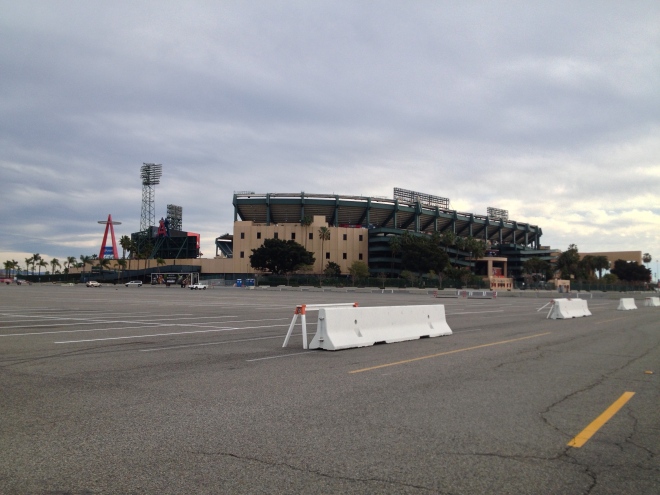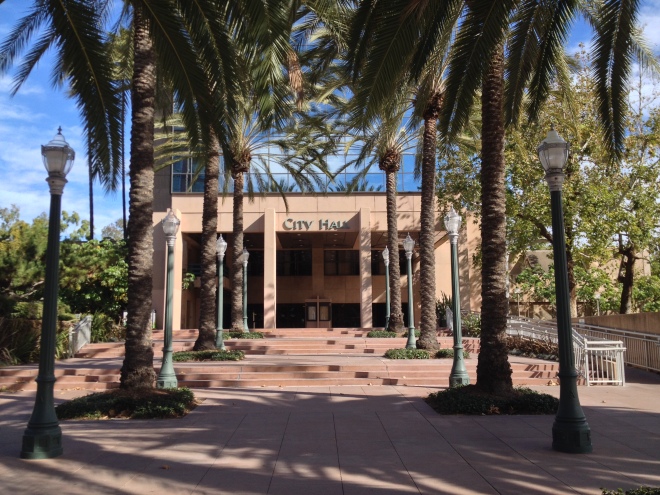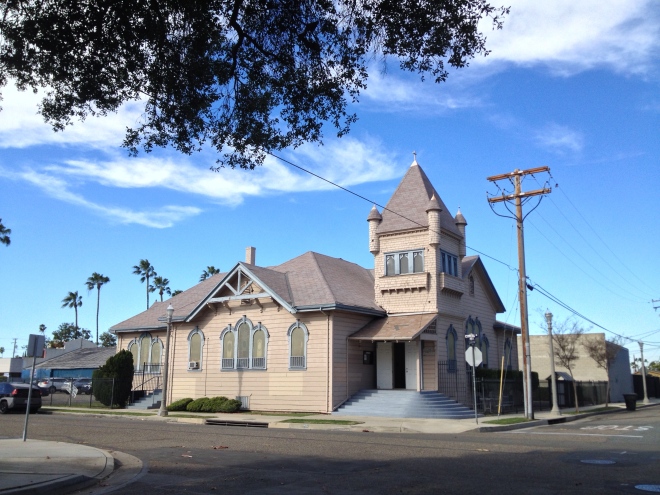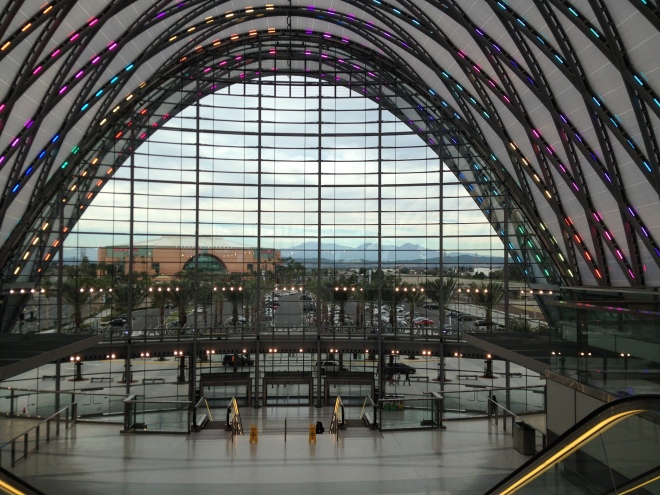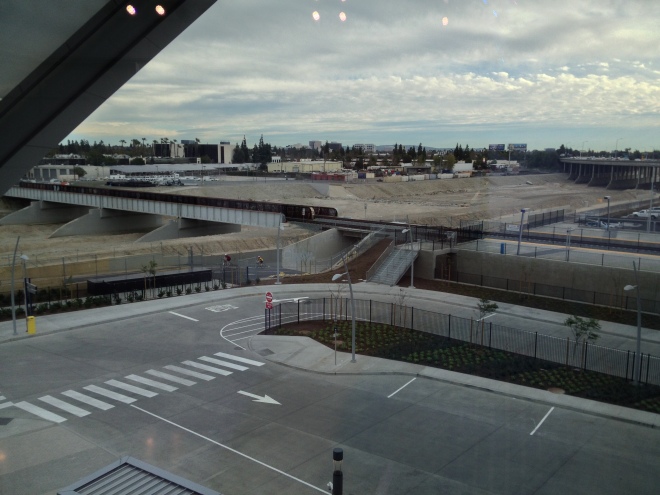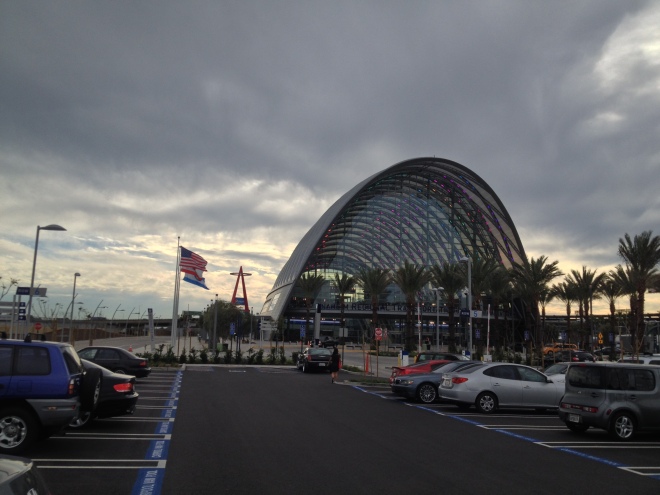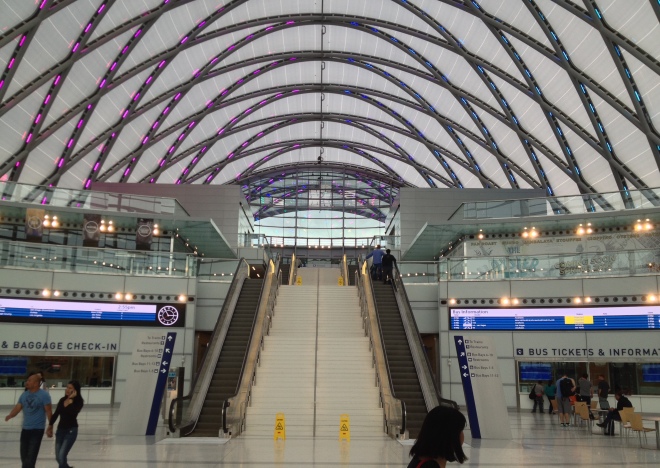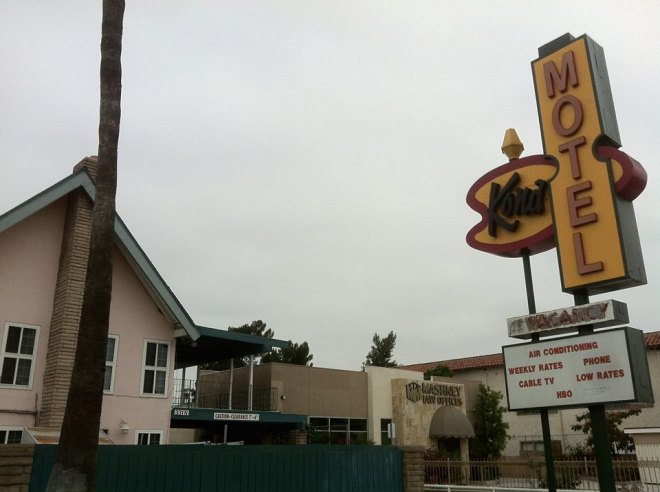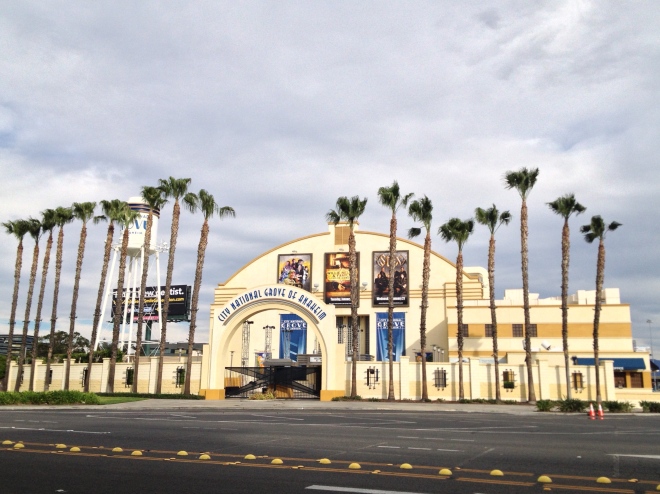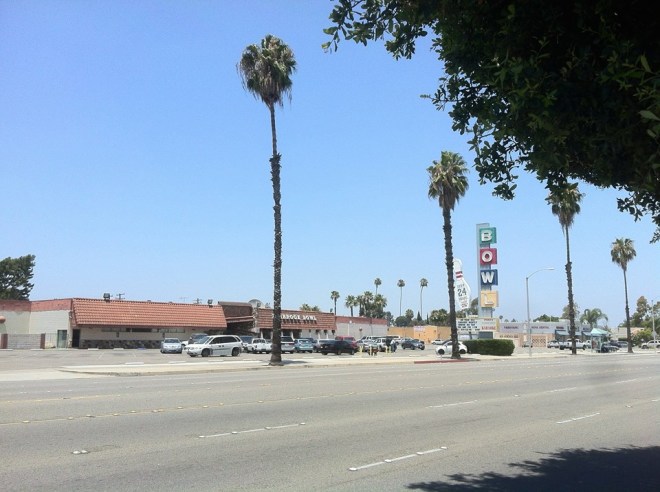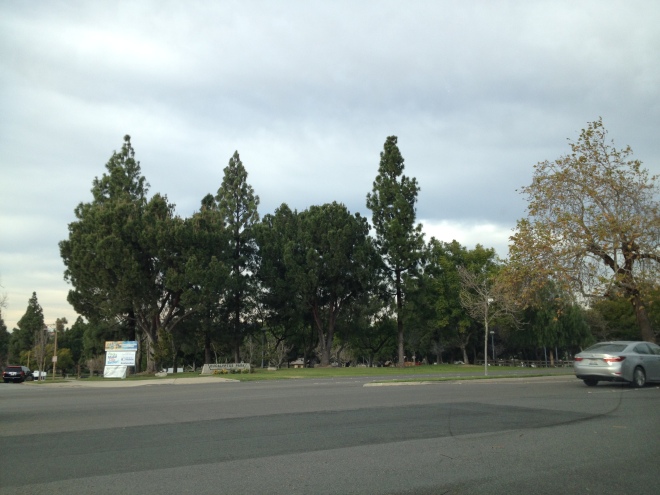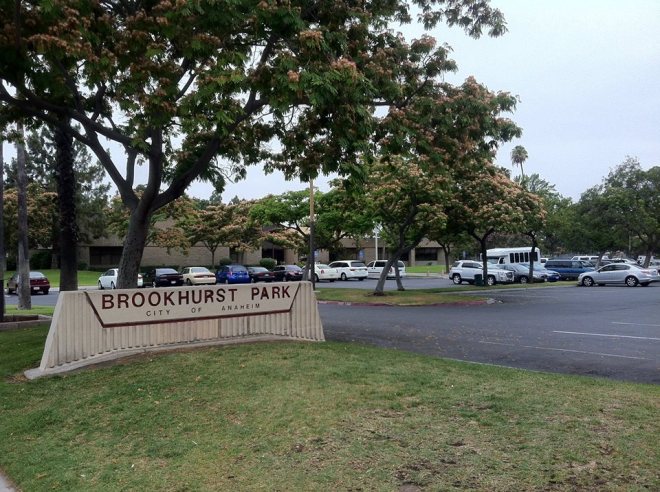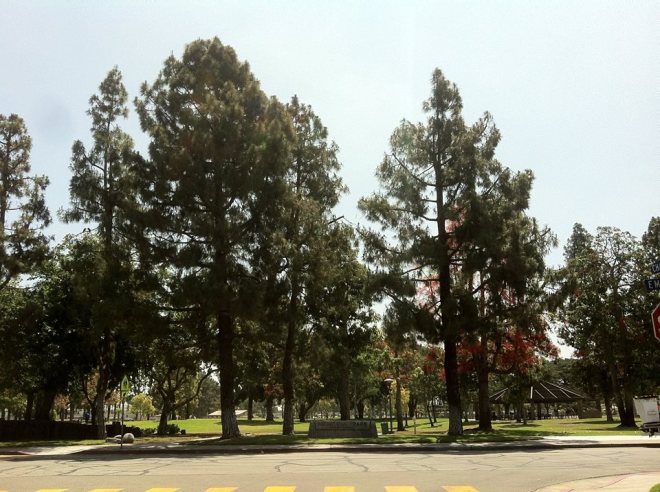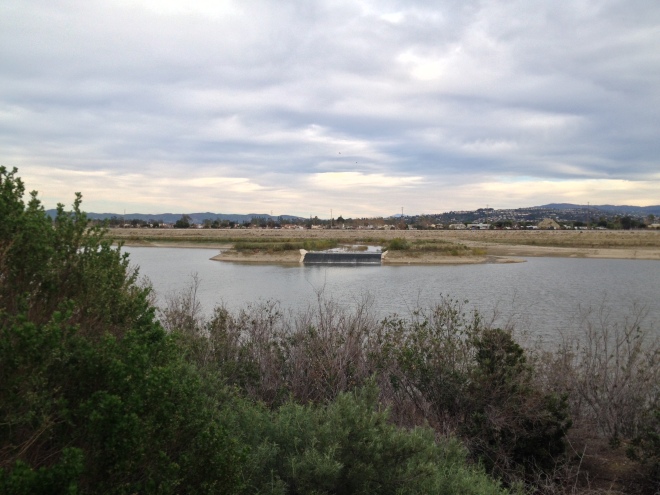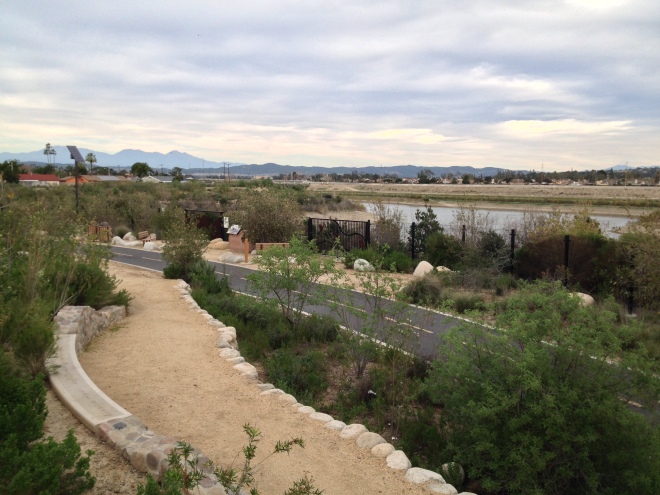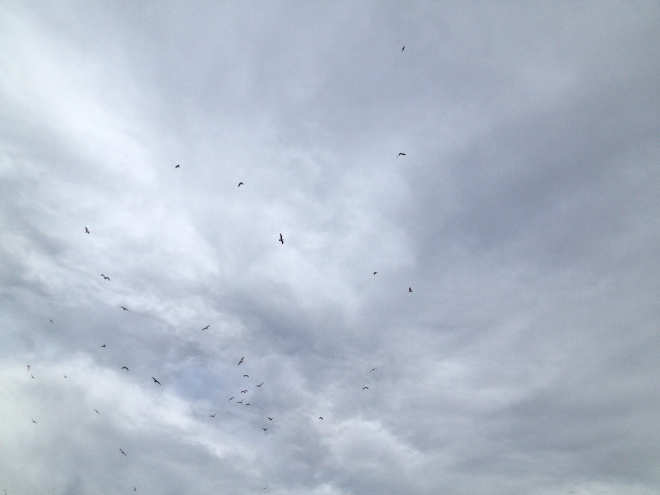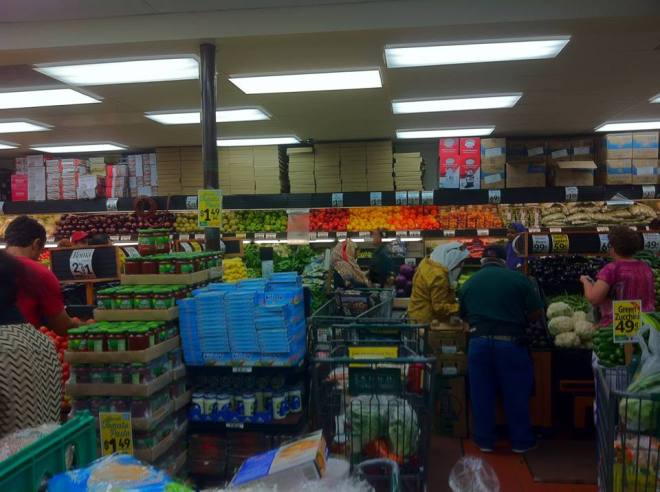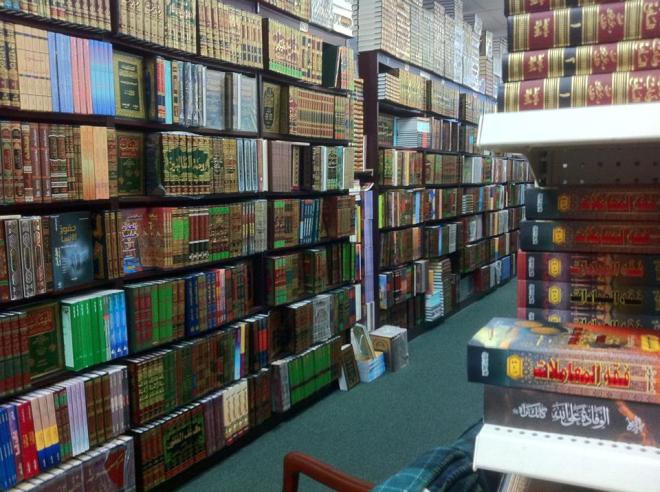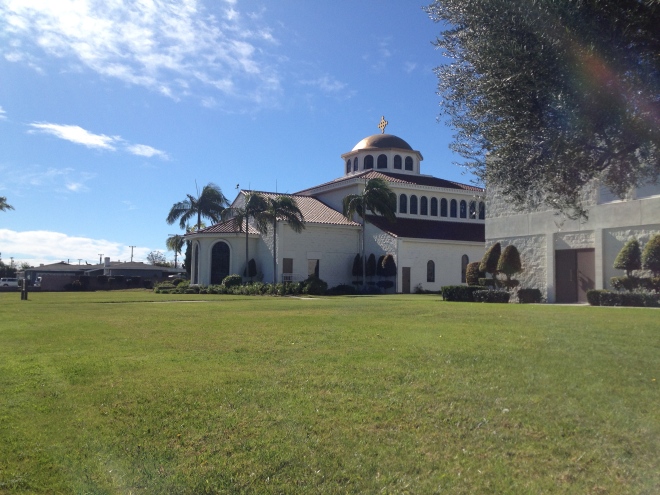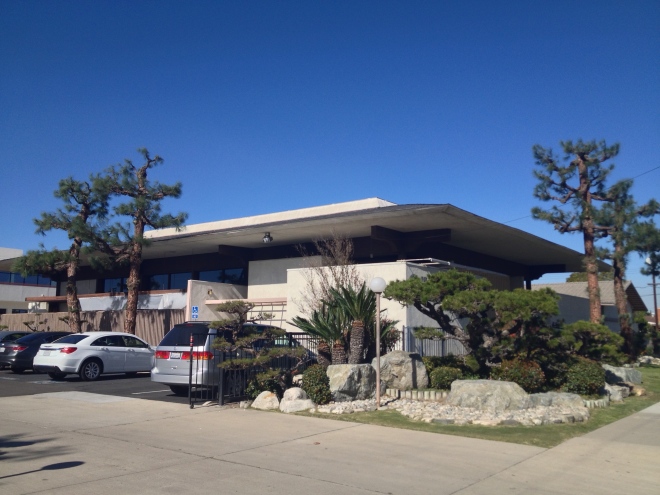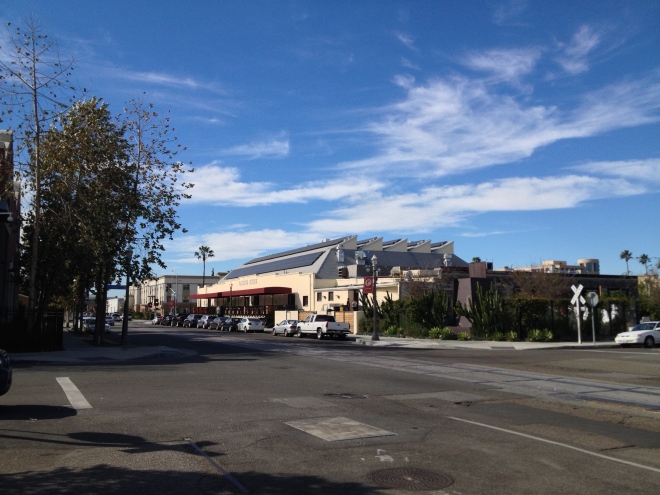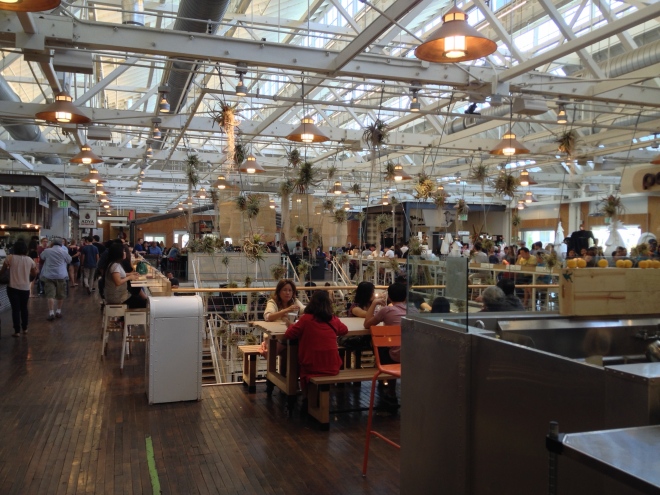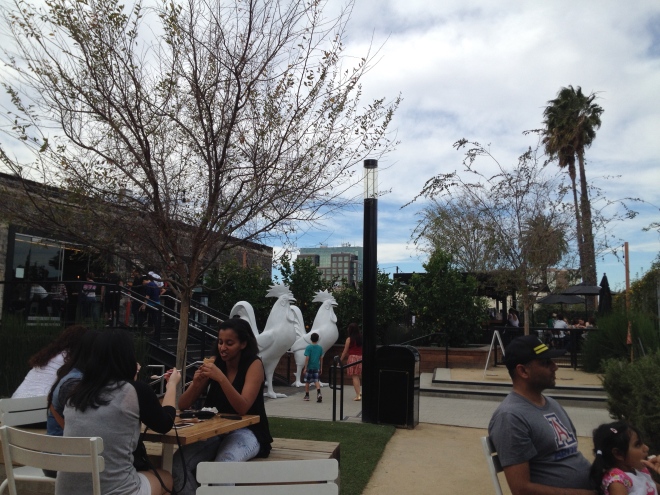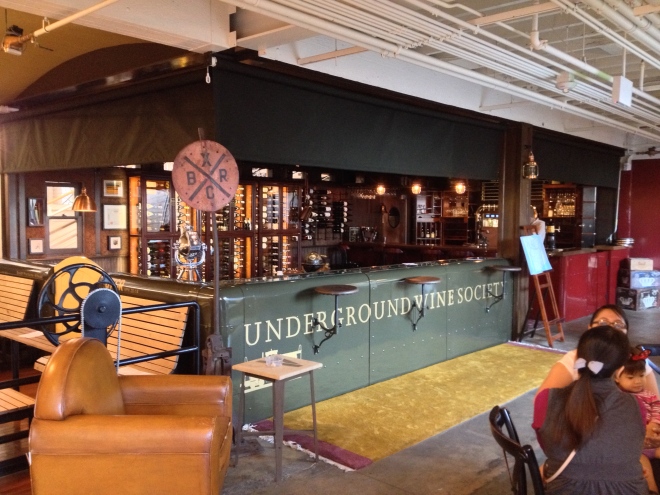FOREWORD

- Pendersleigh & Sons Cartography's Map of Anaheim
For over a year now, Anaheim has topped the polls of communities to be the subject of an episode of California Fool's Gold. Until now I postponed my exploration for several reasons. For one, Anaheim is huge and contains so many points of interest that I suspected (quite rightly) that exploring it to my own satisfaction would require a lot of work. Secondly, Anaheim's huge size requires exploring it by car -- which is not how I usually like to explore, believing as I do that cars fall somewhere between razor scooters and riding mowers for urban adventuring. Finally, so many people have at various times expressed the desire to join in the exploration and coordinating groups is not something I'm cut out for... ultimately it was just Una and I who embarked on the adventure on a warm, windy, winter day.
Anyway, here it is, for your pleasure. If you'd like to vote for other Orange County communities to be the subject of future episodes, click here. If you'd like to vote for Los Angeles County communities, click here. If you'd like to vote for Los Angeles neighborhoods, click here. If you'd like to commission me to explore, map, and write about somewhere else, contact me personally.
*****
INTRODUCTION TO ANAHEIM
Anaheim is the most populous city in Orange County -- which is surprising to me after having visited it because it feels far less developed than its truly urban (but smaller) neighbor, the city of Santa Ana. In fact, to me it feels less urban than Costa Mesa, Newport Beach, or Orange and more like a Garden Grove or Irvine -- which is the only city with more area than Anaheim in the county.

- Pendersleigh & Sons Cartography's Map of North Orange County
Anaheim's population of roughly 350,000 people is spread across 129 square kilometers of city, the linear shape of which stretches like some growth along the 91 a whole 37 kilometers from Cerritos Elementary in Southwest Anaheim to Coal Canyon in Anaheim Hills. Despite the fact that the website Walkscore gives the city a ranking of 51 out of 100 (meaning "somewhat walkable"), it is organized around several walkable but disconnected "centers" like The Colony, Northwest Anaheim, Anaheim Resort, Southwest Anaheim, and Southeast Anaheim. Even the most walkable, the Colony, isn't exactly a pedestrian's paradise and I wouldn't be surprised if no one in the city's history has attempted to explore them all on foot.
The largest employer in Anaheim is Disneyland and its presence in Anaheim has surely made Anaheim the most-visited community in Orange County. Although physically Disneyland only covers 1.5% of Anaheim, its existence seems to infuse all of Anaheim with an air of fantasy and an aspirational attitude (in Disneyspeak, "imagineering"). Although Disneyland tends to overshadow the rest of Anaheim (and Orange County for that matter), and although I love the place, I tried to focus my attention on the other 98.5% of the place that once billed itself as "America's Hub of Happiness."
*****
GEOGRAPHY OF ANAHEIM
Most of Anaheim is located in the broad, flat floor of the Santa Ana Valley and south of the West Coyote Hills, although it extends east into the foothills of the Santa Ana Mountains. Anaheim is located in North Orange County and is bordered by the communities of Orange, Garden Grove, and Stanton to the south; Cypress to the southwest, Buena Park to the west; Fullerton, Placentia, and Yorba Linda to the north; and a large, undeveloped, unincorporated Windy Ridge area to the southeast.
EARLY HISTORY
Whats now Anaheim and the surrounding area was for thousands of years home to the Acagchemem, Iviatim, Kumeyaay, Kuupangaxwichem, Payómkawichum, Taaqtam, and Tongva/Kizh nations. The Tongva are believed to have arrived from the Sonoran Desert around 3,000-3,500 years ago and they established numerous villages in what's now Orange County, including Hotuuknga and Pasbenga near what's now Anaheim.
SPANISH ERA
In 1542, explorer Juan Rodríguez Cabrillo claimed all of California for the Spanish Empire but the Spanish Conquest didn't really get under way until 1769, when Spanish explorer Gaspar de Portolà led an overland expedition through the area accompanied by a Franciscan friar, Junípero Serra Ferrer, who named the area Valle de Santa Ana. Subjugation of the indigenous population was made possible with disease and the establishment of Spanish forts and missions. In 1776, the Spanish established Mission San Juan Capistrano about fifty kilometers to Anaheim's southeast on land formerly lived on by the Acagchemem. In 1784, Spanish governor Pedro Fages granted former soldier Jose Manuel Nieto the 1,200 square kilometer Rancho Los Nietos. After Nieto's death in 1804, the vast lands passed to his wife and their four children.
MEXICAN ERA
In 1821, Mexico won independence from Spain after eleven years of war. The victorious Mexicans secularized the missions and divided the huge ranchos into smaller ones and in 1837, the 146 square kilometer Rancho San Juan Cajón de Santa Ana (containing the modern cities of Anaheim, Fullerton, and Placentia) was carved from Rancho Los Nietos and granted by Mexican Governor Juan Bautista Alvarado to another former soldier, Juan Pacífico Ontiveros.
EARLY AMERICAN ERA
The US invasion of Mexico began in 1846 and by the conclusion of the ensuing Mexican-American War in 1848, California was newly under the control of the US. However, the Treaty of Guadalupe Hidalgo required the continued recognition of the pre-existing Mexican land grants and thus all of Rancho San Juan Cajón de Santa Ana remained in the hands of the Ontiveros family until 1853, when Ontiveros sold a large portion of his holdings to to Abel Stearns and moved to Santa Barbara County. In 1857 Ontiveros sold a much smaller area, roughly 469 hectares, to an Austrian-American named George Hansen, who represented the interests of fifty German-Americans then living in the San Francisco area.
FOUNDATION OF ANAHEIM
The Anaheim Colony was founded in 1857 by immigrants with origins in Rothenburg ob der Tauber, Franconia (in Bavaria) who'd emigrated to the Northern California where they were persuaded by two Los Angeles vintners, John Frohling and Charles Kohler, to relocate to the Southern California. Acting on behalf of the Los Angeles Vineyard Society (founded in San Francisco), Hansen handled the purchase of land for the which they named Annaheim (one of the "n"s was soon dropped).
MOTHER COLONY HOUSE
The modest Mother Colony House is the oldest surviving home in Anaheim, built in 1857 for Hansen. In 1872 it was purchased by Vicenta Sepulveda de Carrillo. Saloon-owner Frederick "Fritz" Ruhmann bought the home in 1886. It later housed actress Madame Helena Modjeska and author Henryk Sienkiewicz. It was saved from demolition by the Mother Colony Chapter of the Daughters of the American Revolution, who oversaw its relocation from its original spot at the intersection of Anaheim Boulevard (then known as Los Angeles Boulevard) and Cypress Street to its current home in Founders’ Park, where it is open for tours on the first Saturday each month, from 9am to noon.
MELROSE-BACKS NEIGHBORHOOD
The first four families of colonists (including the Kuechels, the Melroses, and the Backs) arrived in Anaheim in 1859 and the are in which they built their homes is now known as the Melrose-Backs Neighborhood. The homes along Adele and Philadelphia (originally known as Hedwig) streets includes six historically significant homes.
The Kuchel-Melrose House was completed in 1860 for Conrad Kuechel (the original president of the Los Angeles Vineyard Society) and his wife Samantha -- spelling of the family name later changed. It was there that they gathered to celebrated Erntedankfest from which the house acquired its informal name, "Harvest House." It was there too, in 1868, that the agriculturalists first planted the seeds of Orange County's ultimate secession from Los Angles, which came to fruition in 1889. In 1912, the single-story Greek Revival-style home was divided into two and now resides at the addresses of 226 and 228 E. Adele.
The Fred Backs Honeymoon Cottage is a single story Craftsman built in 1903. It was originally located on Adele but in 1911 was rotated to face Hedwig and today its address is 321 N. Philadelphia St.
The Fred Backs Jr. House (at 317 N. Philadelphia) is another Craftsman, with Orientalist elements, and was built from 1907 to 1908. Scottish-American immigrant
Richard Melrose was another of the organizers of the wine-making colony formed by Ferdinand and Joseph Backs. He also owned Anaheim's first furniture store and undertaking business. He and his wife, Mary, built their Craftsman (with Tudor elements) Melrose House at 307 N. Philadelphia, in 1914.
The Craftsman (with Orientalist elements) Judge Ames House (303 N. Philadelphia) was built in 1911 for Melrose's law partner.
ANAHEIM CEMETERY
The city's first cemetery, Anaheim Cemetery, was founded in 1866 and is the oldest public graveyard in Orange County. It's the final resting place of several locally recognized figures and families, including the Hartmanns, the Kraemers, the Langenbergers, the Schumachers, the Rimpaus, William Koenig, Thomas Henry Kuchel, Dona Vincente y Serrano Sepulveda Yorba Carillo, 48 Civil War veterans, and Ezra Benedict Kellogg, a veteran of the War of 1812. It's also home of the first public mausoleum built on the West Coast, which was installed in 1914.
INCORPORATION
Anaheim was the first city in what's now Orange County to incorporate, having done so in 1870 when it was still within Los Angeles County. Anaheim grew significantly in the 1870s, which proved to be a decade of several significant developments. Solomon Goldstein and Samuel Davis established Anaheim Brewery in 1870 (it closed in 1920 after the enaction of Prohibition). 1871 saw the launch of Anaheim's first newspaper, The Southern Californian, which in 1874 changed its name to The Anaheim Gazette. The Anaheim Public Library was founded in 1873. In 1875, the Southern Pacific Railroad reached town, lessening Ahaneim's isolation and spurring more growth. St. Michael's Episcopal Church (rebranded as, I kid you not, as The Chapel at St. Michael's Episcopal Church) was dedicated in 1876 (the English Country-style church was moved to its current location in 1955).
A now huge (and City Council recognized historic tree) Moreton Bay Fig Tree was planted near the western boundary of the Colony's Vineyard Lot C-7 by the Horseman family some time before 1876. It was imported from Australia by Anaheim's first nurseryman, Timothy Carroll, and later served as a model for Disneyland's Swiss Family Robinson Treehouse (now Tarzan's Treehouse).
RAMON PERALTA ADOBE AND MUSEUM
Thirteen kilometers east of the Anaheim Colony (but now located within Anaheim) is the Ramon Peralta Adobe, built in Santa Ana Canyon in 1871. Peralta died in 1873 and in 1881 it became the home of Pablo Dominguez and his wife, Felipa Yorba Dominguez. The Dominguez family sold the adobe to E. Walter Pyne in 1908. In 1920 it became the Canyon Cafe and gas station. A building which surrounds the adobe (and is home to a realtors office) was added sometime after 1935 and according to the historical plaque, it was restored in 1985. It re-opened as a museum in 2006 and is open 11 am - 1 pm the first Sunday of each month (except in May) for a grand total of 22 hours per year and located within are historical exhibits and artifacts.
ANAHEIM'S CHINATOWN
In the 1880s, a population of Chinese-Americans established a Chinatown along Charles Street between Anaheim Boulevard and Lemon Street. Many of the Chinese had worked on the railroad but stayed to work in agriculture. Between 1884 and 1889, a blight (Pierce's Disease) destroyed more than 400,000 grapevines and many agriculturalists thus switched from growing Mission grapes to citrus, walnuts, Anaheim chilis, sugar beets, lima beans, potatoes, cabbages, and strawberries. Anaheim's Chinese fieldworkers were later commemorated by Millard Sheets in mosaic installed at the Home Savings Building (currently a Chase Bank) on Harbor Boulevard. Although recognized for their contributions today, a century ago they faced suspicion and hostility and the diagnosis of one Chinese with leprosy give the city all the reason it needed to burn nearly the entire Chinatown to the ground on 25 May, 1906. The last Chinatown structure, a private residence, was demolished in 1940. Understandably, most of the Chinese moved out of town, in some cases to Orange, where another Chinatown sprang up along the 500 block of South Glassell. However, relentless anti-Chinese racism was widespread throughout California, which led to a Chinese-American migration to the East which is why, today, the combined Chinese population of San Francisco and Los Angeles is smaller than that of New York City.
THE WOELKE-STOFFEL HOUSE
The two-story George Franklin Barber-designed Queen Anne-style Woelke-Stoffel House was built in 1894 for by restauranteur John Gottlieb Woelke, Anna Wilhelmina Hopp Woelke, Caroline Woelke (John's mother), and the family's children. The Woelke family lived in the home until 1899, when they moved to Los Angeles. It was next purchased by Isaac Lyons, the proprietor of Lyons Hardware Store. In 1904 Lyons sold the house to the Michods, who in turn sold it to the Olmsteads in 1907. That family lived there less than a year before selling it to Peter Stoffel and his family would buy it, and for whom it would come to be named. After Stoffel's death, his wife Marie remained there until she too passed and in 1949 and at that time it faced demolition. It was saved by John Dwyer who moved it to Founders' Park where it's joined today by other historic outbuildings and structures including the Mother Colony House, a windmill, an orange grove, and a modern public restroom.
THE KROGER-MELROSE DISTRICT
Located just west of Citrus Park are a number of Queen Anne cottages, California Craftsman bungalows, Tudor Revival and Spanish Colonial Revival homes were built between 1900 and 1915. The area, hemmed in by Lincoln Avenue, South Kroger Street, West Broadway, and South Philadelphia Street, is today known as the Kroger-Melrose District. It was posted to the National Register of Historic Places in 1985 and twelve years later it became the city's first protected historic district.
CARNEGIE LIBRARY ANAHEIM/MUZEO
The Carnegie Library Anaheim was built between 1908 and 1909. The Classical Revival-style building was designed by John C. Austin (designer of Shrine Auditorium and co-designer of Griffith Observatory and Los Angeles City Hall). It operated as a public library until 1963. In 1987, after years of serving as personnel offices for the City of Anaheim (City Hall is located across the street), it became home of the Anaheim Museum. It's now part of MUZEO ("museum?"in Esperanto and all-caps),"Southern California's newest museum, a center for arts, knowledge, entertainment and culture," which is open Tuesday - Sunday from 10am to 5pm.
THE TRUXAW-GERVAIS HOUSE/WHITE HOUSE RESTAURANT
The Colonial Revival-style Truxaw-Gervais House (887 S. Anaheim Blvd) was built in 1909 for Dosithe Gervais. It was sold to George Waterman in 1916, who soon after sold it to physician John Truxaw and his wife, Louise. There the couple raised eight children before John died in 1952 and Louis died in 1969. In 1978 a woman bought and renovated the home with the dream of opening a toy store which never materialized. In 1981, Jim and Barbara Stovall bought it and dreamt of demolishing it to make way for a condominium development. That dream too was never realized and on the last day of the 1981 it re-opened as a restaurant, Thee White House, which in 1987 was taken over by chef Bruno Serato who changed its culinary focus to Northern Italian cuisine. It's now known as Anaheim White House Restaurant.
THE ANAHEIM ORANGE & LEMON ASSOCIATION
When Prohibition was enacted in 1919, some locals turned to bootlegging but far more money was made on oranges than grapes in the decades that followed. The Anaheim Orange & Lemon Association incorporated in 1918 and its Mission Revival-style Anaheim Citrus Packing House was completed in 1919 (or was it 1911? -- sources seem to vary considerably). There, citrus was packed and sent by rail throughout the country. Five brands were created by Duncan Gleason for the association: Delicia, Doria, Favorita, Meritoria, and Sonia. The association stopped processing lemons in 1931 and in 1936 the company changed their name to the Anaheim Valencia Orange Association. The association's last season of operation was in 1957. It was later reborn as the Anaheim Packing District (more on that in a bit).
THE KU KLUX KLAN IN ANAHEIM
In the 1920s, four members the Ku Klux Klan wormed their way into Anaheim's governing council, the Anaheim Board of Trustees. That might sound shocking to modern readers but back then even president Woodrow Wilson campaigned for compulsory sterilization of criminals and the mentally retarded and was a eugenicist and white supremacist who normalized racial segregation and praised the film Birth of a Nation. That film (based on the novel, The Clansmen, written by the president's friend Thomas Dixon) was released in 1915 and helped revive the Reconstruction Era terrorist organization.
Birth of a Nation romanticized a secretive organization of racist terrorists who murdered and otherwise harassed black Americans from 1865 until their disbandment around 1871. The second incarnation of the KKK were less secretive. They were also much more broadly popular and powerful, enjoying an estimated membership of more than three million members. The new KKK weren't just racists, but self-proclaimed Christian fundamentalists, and they expanded the target of their hatred from blacks to heathens (e.g. Catholics and Jews) and sinners (e.g. bootleggers and divorcees).
Naturally the KKK used their power to promote political conservatives and they helped elect sixteen US Senators, numerous Representatives and uncounted numbers of local officials. In fact, they claimed to control 24 of the 48 state legislatures. In Anaheim, they added the acronym KIGY (an acronym for "Klansman, I Greet You") to street signs as a friendly hello to fellow right wingers. A klan rally in Anaheim attracted 20,000 attendees.
Many Anaheim residents were understandably horrified. The USA Club formed to oppose the KKK. The club published the names of the four klansmen in the board of trustees as well as ten members of the police department and other city officials. In February, 1925, 95% of registered voters came to the polls and voted out the klansmen.
ORANGE COUNTY'S FIRST SKYSCRAPER
In 1924 (when the sky was considerably lower) construction was completed Orange County's first skyscraper, the six-story American Savings Bank of Anaheim (aka Samuel Kraemer Building). Its developer, Samuel Kraermer, was a rancher, farmer, and businessman who'd married Angelina Yorba, a member of the powerful, Spanish Yorba family. In 1919, when Union Oil Company discovered oil on his property, he went from merely being loaded to one of the wealthiest people in the state. He also developed Anaheim's Angelina Hotel and fathered eight children before dying in 1937. His Kraemer Building, designed by local architect M. Eugene Durfee, remained the tallest building in Orange County until the 1962, when Anaheim's eleven-story Disneyland Hotel was completed. The Kraemer Building suffered the the installation of mineral fiber ceiling tiles and stucco paneling in the 1970s, both of which were thankfully removed when it was restored to its former splendor in 2003.
PHILLIP ACKLEY STANTON HOUSE
The Phillip Ackley Stanton House is a huge Mission Revival hacienda that was built in 1929 for Col. Philip A. Stanton. Stanton was an Ohio native who moved to California in 1887 and went on to serve as president of several real estate companies. He was at least partly responsible for the developments of Pacific City and Bay City (now Huntington Beach and Seal Beach) and of course the community of Stanton was named after him. He passed away in 1945 and his 700 square meters home later proved to be not just enough to one toff but an entire school -- Fairmont Preparatory Academy moved in to Stanton's old digs in 1994.
YEARS OF DISASTER
In the 1930s, Southern Californians were hit by a series of disaster. Just before the decade kicked off, the US suffered the most devastating stock market crash in the history, which helped kick off the Great Depression. In 1933, the 6.4 Long Beach Earthquake rocked the region, killed 120 people, and caused costly damage to many Anaheim buildings. In 1938, most of Anaheim was severely flooded when the Santa Ana River overflowed its banks, which lead to much of it being channelized and damned.
The 1940s suffered fewer local disasters but America did from 1941-1945 many people lost their lives fighting in World War II. After the war's end, Anaheim and much of Southern California witnessed a population boom and rapid suburbanization and orange groves were ripped down as tract homes went up.
DISNEY YEARS
In 1953, the 5 Freeway arrived in Anaheim and between that year and 1955, the area of the city quadrupled through a series of annexations. In 1953, Walt Disney purchased 65 hectares of land in Southwest Anaheim and his Disneyland Resort opened in 1955. Seemingly overnight, the focus of Anaheim's economy shifted from agriculture to tourism and industry.
From its inception Disneyland has been the a primary exemplar of simulacrum and hyperreality. The first "themed land" inside the park's main entrance was Main Street, U.S.A. is modeled after Marceline, Missouri as it existed around 1910. New Orleans Square was added in 1966, designed to resemble the crescent city as it appeared in the late 19th Century. Disneyland's importance and vision inspired criticism from cultural theorists and intellectuals, most famously Jean Baudrillard, Umberto Eco, and Julian Halevy.Disneyland has inspired more love than hate -- including amongst New Urbanists and Utopians. One, Ray Bradbury, promoted the idea of Walt Disney running for mayor of Los Angeles on the ground that only he could bring "a working rapid transit system built without any more surveys, and turn it into a real attraction so that people will want to ride it." Disney was a huge train nerd and had his own private live steam railway at his home in Holmby Hills. Through all of Disneyland's pre-construction designs, each and every one depicted the park being circled by the Santa Fe & Disneyland Railroad.
In fact, even though nearly everyone who visits Disneyland arrives by car, one in the park they walk considerable distances and brave long lines filled with coughing, unvaccinated measles-carriers just so that they can grab a seat on a monorail, steam train, roller coaster, or fake log -- all of which are essentially fanciful versions of public transit. Outside the park, Disney operates Anaheim Resort Transit (ART) and Disney GOALS, the latter a free bus service for low-income youth in Anaheim.
There is another side of Disneyland worth mentioning that is less-promoted and less public -- that would be the private side. Perhaps the best known of the Disneyland private areas is Club 33, built in 1967 (months after Disney's death) originally as an exclusive retreat for the park's wealthy investors. Disney maintained a private residence, a Victorian-style apartment located above the Main Street, USA firehouse. Some of the less well-known private areas include the luxury Dream Suite, located above Pirates of the Caribbean and the fairly rudimentary gym inside the Matterhorn, for the use of employees.
HOBBY CITY
There is another side of Disneyland worth mentioning that is less-promoted and less public -- that would be the private side. Perhaps the best known of the Disneyland private areas is Club 33, built in 1967 (months after Disney's death) originally as an exclusive retreat for the park's wealthy investors. Disney maintained a private residence, a Victorian-style apartment located above the Main Street, USA firehouse. Some of the less well-known private areas include the luxury Dream Suite, located above Pirates of the Caribbean and the fairly rudimentary gym inside the Matterhorn, for the use of employees.
HOBBY CITY
In 1955, the same year that Disneyland started, Bea and Jay DeArmond opened a strange shopping center comprised of a collection of antique, craft, and hobby shops known as Hobby City on the former site of a chicken ranch. To avoid long commutes to and from their shops, in 1979 Jay built a half-scale replica of the White House which became both the couple's home and the location of the Hobby City Doll & Toy Museum.
Jay died of a heart attack in 1982 but Bea continued to live above the museum. In 1994, the DeArmond children decided to open a small amusement park on the four hectare property which they named Adventure City. Bea died in 2002 and around 2009 the doll museum seems to have been converted into the White House Event Center at Hobby City.
The other specialty shops of Hobby City have over the decades included ones selling baseball cards, Cabbage Patch Kids, coins, pet fish, gems, glasswork, metal art, models, Native American jewelry,lizards, pianos, stamps, teddy bears, and more -- but for me half the attraction (as is the case with many shopping centers) is the kitschy architecture, which Hobby City's case includes examples of both space age and old west looking storefronts. Hobby City, too, was very nearly turned into a condominium development but survives for the time being, although the current focus seems to be almost entirely on Adventure City and the event center. In fact, the old Hobby City sign has come down and when I arrived, I wasn't even sure what it was that I'd stumbled upon.
I didn't go into Adventure City, "The Little Theme Park that's BIG in Family Fun," as I had more to explore and because it looked to be geared toward toddlers and their parents. Being an adult male without children of my own, walking around a bunch of toddlers and snapping pictures seemed likely and understandably to arouse suspicion and unwanted attention. From the outside I could make out a Party Tree (available for rental), some small rides, and from the smell of it, there seems to be a petting zoo.
THE PHOENIX CLUB
The Phoenix Club was established in 1960 to celebrate and promote German-American heritage. It does this, in part, by annually observing Oktoberfest and Rosenmontag (essentially Germany's version of Mardi Gras). The gasthaus, Bierstube, serves German food, drinks, and has a happy hour from Tuesday - Thursday from 3 pm - 7 pm and Friday - Saturday from 4 pm - 6 pm. The Phoenix Club also includes a grand ballroom, an event center, and a garden pavilion, which host other special events. To read my Block By Block piece, Kitsch and Kultur: Exploring SoCal Bavaria, click here.
ANGELS STADIUM
Groundbreaking on the new Angels Stadium began in 1963, to accommodate a baseball franchise which had been founded in Los Angeles in 1892. The Dodgers were imported from Brooklyn in 1957 and until 1966, the they and the Angels shared Dodger Stadium. After that the Angels moved to Angels Stadium, officially known today as Angel Stadium of Anaheim (but colloquially known as The Big A). I haven't been inside but outside there's a 70 meter tall, 190 metric ton sign with a halo that lights up whenever the angels win. In front of the main entrance there are two giant (size: 649?) Angles helmets.
ANAHEIM CONVENTION CENTER
The Anaheim Convention Center opened in 1967 and today the expanded complex is the largest convention center on the West Coast. The striking, Googie-style, space age concrete building was designed by Craig Bullock for Adrian Wilson & Associates. It was originally home of the American Basketball Association's Anaheim Amigos (who moved to Los Angeles Sports Arena and became the Los Angeles Stars the following year). The Convention Center has undergone a series of expansions in the decades that followed and today the campus is dominated by glassy structures that dwarf the futuristic venue now known as Anaheim Arena and, in my opinion, both are striking (although the arena more so).
DECLINE, REDEVELOPEMENT, AND PRESERVATION
In the 1970s, many American cities seemed to be in decline. Community redevelopment agencies were formed which usually proposed fixing cities by tearing down old structures and replacing them with shiny, granite and glass buildings situated, preferably, by a generic piece of plop art or a fountain. In the other corner, preservationists mobilized to save everything more than thirty years old, even if those things weren't even built to last that.
In 1973 Anaheim redevelopers launched Project Alpha with the aim of destroying most of historic downtown Anaheim. The preservationists responded in 1976 by forming the Anaheim Historical Society and two years later began efforts to gain recognition from National Register of Historic Places. Preservationists sought to save the Angelina Kraemer Hotel, the California Building, the Carnegie Library, the Church of His Holy Presence, City Hall, the Ferdinand Backs House, First Presbyterian Church, the Fox Theater block, the German Methodist Church, the Kraemer Garage, theMarietta Court Apartments, Martinet Hardware, the Masonic Temple, Pearson Park, the Pickwick Hotel, the Richard Melrose House, the Rosemarie Apartments, the Samuel Kraemer Building, the SQR Store, the Union Pacific Depot, and Zion Lutheran Church. Some were saved, others, like the old City Hall and the Pickwick Hotel were not.
Today Anaheim seems to have achieved something like harmony between the redevelopers and preservationists with the increased implementation of adaptive reuse. Although the economic heart and focal point of Anaheim seems to be the Anaheim Resort District (which includes Disneyland Resort and the Convention Center) Downtown Anaheim/Anaheim's Colonial District was the only part of Anaheim where I saw significant numbers of pedestrians and cyclists. In fact, in the Anaheim Packing District, the crowd actually rivaled those found in quasi-public Downtown Disney.
LITTLE ARABIA
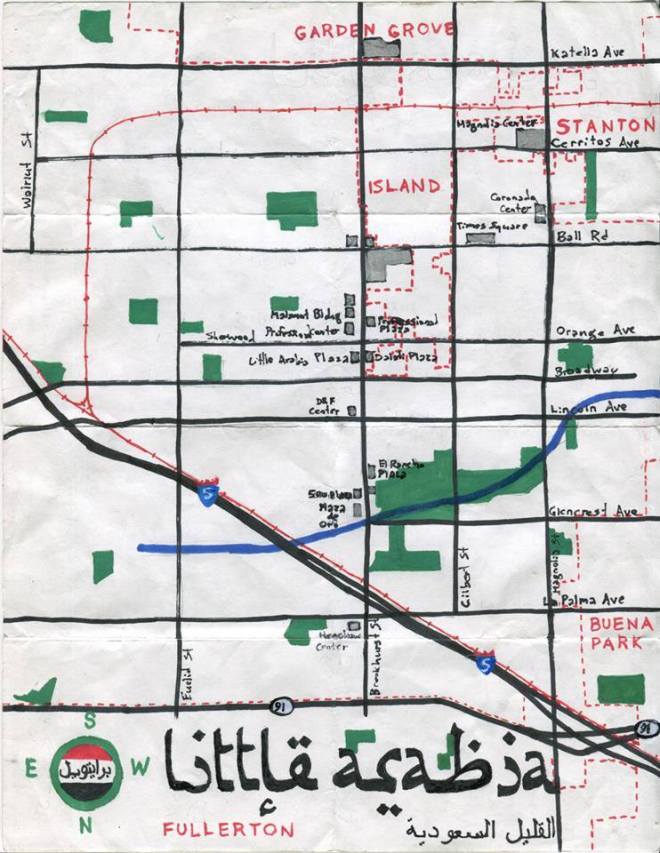
- Pendersleigh & Sons Cartography's Map of Little Arabia
Redevelopment of another sort began to take hold in blighted West Anaheim in the 1980s, where there was a proliferation of no-tel motels, strip clubs, and dive bars. Attracted in part by low rents and ample room to improve, significant numbers of Arab homebuyers and business people began moving into the area. In the 1990s, two high profile entrepreneurs, Lebanese Ahmad Alam and Syrian Belal "Bill" Dalati, together transformed a stretch along and around Brookhurst into an Arab shopping district known as Little Arabia.
In 1996, Alam and other Arabs established the Arab American Council. That same year the Arab World Newspaper began publishing from offices in the Alam-owned Brookhurst Plaza. It was also in 1996 that a Palestinian couple from Nazareth opened Kareem Mediterranean Restaurant, today the oldest-extant Arab restaurant in the neighborhood. After years of effort, Little Arabia was finally granted official recognition in 2014. To read more about it, check out my Block By Block piece, Exploring Anaheim's Little Arabia.
HONDA CENTER
HONDA CENTER
Since 1993, the Anaheim Ducks (named after the Disney film and television franchise, The Mighty Ducks) have played hockey in Honda Center (previously known as the Arrowhead Pond of Anaheim and still colloquially known as "The Pond"). The Pond was designed by Populous, a global architecture firm (nationally based in Missouri) specializing in the design of sports facilities and convention centers but not known for their memorable designs... and Honda Center is not memorable.
*****
ANAHEIM TODAY
Today Anaheim is a medium-sized city whose suburban tracts still resemble the fading stereotype of Orange County but whose diversity of residents challenges increasingly creaky assumptions about the suburbia's complexion and character.. As of the 2010 census, Anaheim had a population of 336,265 people, 53% of whom were Latino of any race (and mostly of (mostly Mexican, Salvadoran, or Guatemalan ancestral origin), 28% non-Latino white (largely Arabic -- Anaheim is estimated to be the second largest Arab-American enclave after Dearborn), 15% Asian (mostly Vietnamese, Filipino, Korean, Chinese, and Indian), 3% black, and 1% Native American. Although the population density of city seems to be rather slight, the census bureau identifies the Los Angeles-Long Beach-Anaheim metro area as the most densely-populated region in the entire country (followed by San Francisco-Oakland).
For many tourists visiting Southern California, Anaheim is just Disneyland, and other attractions like outlet malls, real estates signs, and memorial sidewalks are measured in distance from the amusement park. Naturally efforts have been made to keep tourists in Anaheim and that city (like East Los Angeles, Huntington Beach, and Lancaster) has its own memorial sidewalk where those interested in saying words printed on footpaths can read the names of Carl Karcher, Monsignor John Sammon, John and Donna Crean, and of course Walt Disney on the Anaheim Walk of Stars.
NEIGHBORHOODS OF ANAHEIM
Although I journeyed from one end of Anaheim to another (avoiding freeways, of course, whenever possible), I still feel as though I've much more of Anaheim to see, having walked in so few of its neighborhoods. The best way to get to know a city, after all, is by getting to know its neighborhoods and the best way to do that is on foot. Just what neighborhoods can be found in Anaheim varies according to the source. Balkanization-crazy website Nextdoor lists nearly 100. I reckon that most Anaheim residents would name far fewer but probably nearly all can agree on the existence of Anaheim Hills, Anaheim Resort, Downtown Anaheim,East Anaheim, East Center Street, the Hill and Canyon Area, the Anaheim Historic District, Hotel Circle, Little Arabia, North Central, North Euclid, Pacificenter, Sycamore Canyon, The Canyon, The Highlands, The Summit, West Anaheim, and the Platinum Triangle -- the fastest growing neighborhood in Orange County.
GETTING THERE AND AROUND
I've already briefly mentioned a few alternatives to driving for would-be visitors and explorers. Anaheim launched a pilot bike share program but that has ended and has yet to return. It's worth noting that all of Southern California's bike share programs have thus far been limited to Orange County, a region perhaps not generally thought of as among the most bike friendly. If you're in the market for a bicycle, or just need to get yours tuned up, in Anaheim there's Anaheim Bicycle, Big Wheel Bicycles, BikeCraze and Board Shop, Duke's Bicycles, Live 4 Bikes OC, OC Bicycle & Sporting Goods, Pacific Bicycle Repair, and Rock N-Road Cyclery. There is at least one Anaheim bicycle club, Canyon Velo Cycling Club. Anaheim is also served by the Santa Ana River Trail (SART), a currently 39 kilometer long paved path which ends near the border of Corona, in Riverside County.
OCTA's 24, 26, 38, 43, 71,91, 147, 167, 213, 410, and 411 lines all serve Anaheim as do Disney's ART and GOALS shuttles. Anaheim is aslo served by trains. Anaheim Canyon Station is served by Metrolink's IE-OC Line and Amtrak's Pacific Surfliner and Metrolink's Orange County Line both stop (along with ART, Greyhound, Megabus, OCTA and someday both California High-Speed Rail and maybe the California-Nevada Interstate Maglev) at the newly-opened Anaheim Regional Transportation Intermodal Center (ARTIC), which is also conveniently situated next to the SART and includes bike lockers.
The station's glassy design reminds me both of the Taipei's Wudie Museum (but with all of the rainbow of colored nights one might associate more with Shanghai) and the blimp hangars at Marine Corps Air Station Tustin. Tenants scheduled to open for business soon include The Alchemists, The Lost Bean,Mission Market, The Oyster Bar, and Ritter's.
STAYING IN ANAHEIM
There are many lodging houses in Anaheim -- surely most owe their existence to the presence of Disneyland. Actually, the entire Anaheim skyline owes its profile almost exclusively to resort hotels and the tallest building in town, the 19-story Anaheim Marriott, is typical of the city's high-rises (although there are plans to construct six more high-rises in the Platinum Triangle, the tallest of which would be 35 stories).
Many of the motels have names and exteriors with a vague fantasy theme. Although I have't seen the interiors of any, I'd be surprised if most of them continue their whimsical themes to the actual rooms. For example, from the outside Disney's Grand Californian Hotel & Spa looks like a huge, California Craftsman mega-bungalow. From what I've been told, however, the guest rooms are rather more ordinary and any early 20th century charm found in a wooden headboard or antique-looking lamp is extinguished by the presence of typically puffy couches, blackout curtains, and bulky entertainment centers. Disneyland Hotel is probably the same story although having been designed by Pereira & Luckman its architecture at least it pretty great.
Away from Disneyland I expect that the seediness of Anaheim motels varies considerably but juding them solely by their signs and exteriors I find charm in the mock Tudor Anaheim Camelot Inn & Suites, the Anchor, the Americana, the Alpine Inn (which looks like a Clearman's North Woods Inn), the Crown, the Kona, the Polynesian, the Robin Hood, and the Sandman. The Rodeway Inn & Suites Near Convention Center, despite its boring name, seems designed to evoke a Tuscan 99 Cents Only store. On the other hand, some motels merely have colorful names but little else to obviously recommend them, including, sadly, Candy Cane Lane, Desert Palms, Dolphin's Cove, the Frontier, Little Boy Blue, Motel Moonlight, and Red Lion.
MUSIC OF ANAHEIM
The biggest music venue in Anaheim is The City National Grove of Anaheim, a 1,700 capacity space located in the vast parking lot next to Angels Stadium. It was originally a theme-restaurant called Tinseltown but first converted into a live music called The Sun Theatre. It is also notable for having been the venue where Una saw Regina Spektor perform in 2007. Other Anaheim music venues include Chain Reaction and a House of Blues, The Doll Hut (one of the oldest punk clubs in Orange County), and JC Fandango, which has hosted some big names (or at least advertised that it has) including Mikel Erentxun and Moenia. However, when they announced that Los Prisioneros were to play in 1999, I made the long trek from Santa Monica only to find that they did not show (something I'd worried might happen since they'd broken up years earlier). Apparently it's somewhat common practice to advertise band performances that don't actually occur.
The big record store in town is Radiation Records, which specializes in punk. Anaheim stores selling instruments include Anaheim Band Instruments, Music Maker, Pete's Music & Guitar Shop, and Piano Empire Megastore Anaheim's only radio station is KGBN 1190 AM, a Korean-language Christian station. Anaheim also annually hosts the outdoors Concerts in the Canyon too.
For a city as large as Anaheim, it's rather surprising to me how few music acts from there I've ever heard of. In fact, the only Anaheim born musician with whom I'm really familiar is Jeff Buckley. Other acts from Anaheim, however, include Absurdp, Adri-Anne R, Aeon Atmosphere, Alex, Alexander Buenosayres, Androis, Anila, Anne Vandenberg McClain, ArsenikSp, Attack the Music, Aunty Trust, Austin Butler, B.L.U.R, Benni Cinkle, Bob McAskill, Brutis Perux, Bud D., Bullets for Breakfast, Bushido Brown, C.I.A., Canyons, Castor Pollux, Chance Dance, Charlie B., Chris Berens, Chris Morris, City Dwellers, Class, Clinton Wayne, Colin, Counselor Dan, Creatures, Creep Creepersin, Dana Washington, Danny Hasbun, Danny Pryce, Deaf Infect, Deaf Instinct, Death Hymn Number 9, Delta Halos, Devils are Here., Dextro The Man With Infinite Names, Dietra Kruschev, Dirty Red "Da Gift", Divisionary, DJ Alik, Dominic Williams, Don Davis, Downburst, Drew, Dylan Jaymes Crossland, Dylan Mills, The E.R.A., Eden Espinosa, Elos Beatz, Everyday Animals, The Evolution of Real Audio, Fag Rabbit, Foreighn Spies, Fugitive Assassins, FullaFaith, Gadzooks, The Galaxy Kids, Giles Griffin, Good Avery, The Gospels, Grace Oh Grace!, Griffith Sharp, Hemorrhage, Hexlo, Hooray for Our Side, Industrial Priest Overcoats, J.C.B., Jazz Avenue, JJ-Jpsh, John Spence, Jona Lyons, Jurgenwaynemusic, Kapatarus, Keyturn, Killix, Kinestasis, La Femme Psycho, The Legion, Lesser Pissers, Lisa Tucker, LN, Lost Poet, Lovehopecity, Low Places, Mach Keys, Marcus Mumford, Media Blitz, The Messengers Crew, MetalHeadRadio, Mighty Fleiss Radio, Moke Boner the God, My Machete, Naked Aggression, New Way On, Old Rivals, The Orange Effect, Palm Reader, Papa Grizzly, Patrick Bonfrisco, Phobya, Phobya, Plagues, Punk as a Doornail, Raini, Rebel, Reob Nero, Riza, Rogie Lucero, Royals Records, S2TB Recording, Scabsallover, The Scarred, Scarred IV Life, Scott Sechman, Shanell, Shipwrecks, SirenSiren, Smooth-E, The Soft Patches, Sounder, Speach Impediements, Stephanie Floresca, Stu, Subjection, Susie Ibarra, SwayD Danny Day, Tairrie B, TBD, Terezodu, Thee Makeout Party, Thee Rain Cats, ThingWon, Tommy Vonjo, Tony T Nguyen, Transcendent, TreyG, Tristessa, Turtle Rescue League, Ume Shoot, We Streets, Wedding Music Project, Yop B Beats, Youth Leadership America, Zero 2.0, and ~.~`.
ANAHEIM AND THE MOVIES
From what I've seen, Anaheim was never been a big film-producer. The first known film to have been shot there, however, was 1915's The Missing Link, which is currently classified as being lost.
There were formerly several movie theaters in Anaheim, including the Star Theatre (1910-1915), Anaheim Theatre (1917-1983), Fox Anaheim Theatre (1920-1979), Anaheim Drive-In (1955-1990), Mickey Mouse Club Theater (1955-1982 ), Century 21 Theater (1965-late ?70s/early ?80s), Brookhurst Loge (1970-1996), Brookhurst 4 Cinemas (1961-2003), Grand Theatre (1968-1983), Fox Cinemaland Theatre (1968-1998), and Motion Picture Hall Of Fame (1971-1976). As suggested by the dates in parentheses, they've all been closed for some time and near as I can tell, only AMC Theatres at Downtown Disney, Edwards Anaheim Hills Cinemas, Starlight Cinema City, and UltraLuxe Cinemas Anaheim Gardenwalk show films on the big screen today -- and unless I'm mistaken, they're all mainstream, Hollywood theaters. There are still a couple of stores which rent movies too, Mega Video and Movietown.
ANAHEIM ATTRACTIONS AND AMUSEMENTS
For a city as large as Anaheim, it's rather surprising to me how few music acts from there I've ever heard of. In fact, the only Anaheim born musician with whom I'm really familiar is Jeff Buckley. Other acts from Anaheim, however, include Absurdp, Adri-Anne R, Aeon Atmosphere, Alex, Alexander Buenosayres, Androis, Anila, Anne Vandenberg McClain, ArsenikSp, Attack the Music, Aunty Trust, Austin Butler, B.L.U.R, Benni Cinkle, Bob McAskill, Brutis Perux, Bud D., Bullets for Breakfast, Bushido Brown, C.I.A., Canyons, Castor Pollux, Chance Dance, Charlie B., Chris Berens, Chris Morris, City Dwellers, Class, Clinton Wayne, Colin, Counselor Dan, Creatures, Creep Creepersin, Dana Washington, Danny Hasbun, Danny Pryce, Deaf Infect, Deaf Instinct, Death Hymn Number 9, Delta Halos, Devils are Here., Dextro The Man With Infinite Names, Dietra Kruschev, Dirty Red "Da Gift", Divisionary, DJ Alik, Dominic Williams, Don Davis, Downburst, Drew, Dylan Jaymes Crossland, Dylan Mills, The E.R.A., Eden Espinosa, Elos Beatz, Everyday Animals, The Evolution of Real Audio, Fag Rabbit, Foreighn Spies, Fugitive Assassins, FullaFaith, Gadzooks, The Galaxy Kids, Giles Griffin, Good Avery, The Gospels, Grace Oh Grace!, Griffith Sharp, Hemorrhage, Hexlo, Hooray for Our Side, Industrial Priest Overcoats, J.C.B., Jazz Avenue, JJ-Jpsh, John Spence, Jona Lyons, Jurgenwaynemusic, Kapatarus, Keyturn, Killix, Kinestasis, La Femme Psycho, The Legion, Lesser Pissers, Lisa Tucker, LN, Lost Poet, Lovehopecity, Low Places, Mach Keys, Marcus Mumford, Media Blitz, The Messengers Crew, MetalHeadRadio, Mighty Fleiss Radio, Moke Boner the God, My Machete, Naked Aggression, New Way On, Old Rivals, The Orange Effect, Palm Reader, Papa Grizzly, Patrick Bonfrisco, Phobya, Phobya, Plagues, Punk as a Doornail, Raini, Rebel, Reob Nero, Riza, Rogie Lucero, Royals Records, S2TB Recording, Scabsallover, The Scarred, Scarred IV Life, Scott Sechman, Shanell, Shipwrecks, SirenSiren, Smooth-E, The Soft Patches, Sounder, Speach Impediements, Stephanie Floresca, Stu, Subjection, Susie Ibarra, SwayD Danny Day, Tairrie B, TBD, Terezodu, Thee Makeout Party, Thee Rain Cats, ThingWon, Tommy Vonjo, Tony T Nguyen, Transcendent, TreyG, Tristessa, Turtle Rescue League, Ume Shoot, We Streets, Wedding Music Project, Yop B Beats, Youth Leadership America, Zero 2.0, and ~.~`.
ANAHEIM AND THE MOVIES
From what I've seen, Anaheim was never been a big film-producer. The first known film to have been shot there, however, was 1915's The Missing Link, which is currently classified as being lost.
There were formerly several movie theaters in Anaheim, including the Star Theatre (1910-1915), Anaheim Theatre (1917-1983), Fox Anaheim Theatre (1920-1979), Anaheim Drive-In (1955-1990), Mickey Mouse Club Theater (1955-1982 ), Century 21 Theater (1965-late ?70s/early ?80s), Brookhurst Loge (1970-1996), Brookhurst 4 Cinemas (1961-2003), Grand Theatre (1968-1983), Fox Cinemaland Theatre (1968-1998), and Motion Picture Hall Of Fame (1971-1976). As suggested by the dates in parentheses, they've all been closed for some time and near as I can tell, only AMC Theatres at Downtown Disney, Edwards Anaheim Hills Cinemas, Starlight Cinema City, and UltraLuxe Cinemas Anaheim Gardenwalk show films on the big screen today -- and unless I'm mistaken, they're all mainstream, Hollywood theaters. There are still a couple of stores which rent movies too, Mega Video and Movietown.
ANAHEIM ATTRACTIONS AND AMUSEMENTS
Disneyland is, of course, one of the most popular tourist destinations in the universe and definitely Anaheim. There's also the aforementioned Adventure City. Other amusements can be had at Bowlmor Anaheim, Camelot Golfland, Captain's Auction Warehouse, Concourse Bowling Center, Flightdeck Flight Simulation Center, IGZ Internet GamerZ Cyber Café, Starcade, Video Game Geeks, and the beautiful Linbrook Bowl, which in addition to bowling includes pool, a restaurant, and karaoke.
ANAHEIM PARKS
Thankfully, not all parks in Anaheim are of the amusement, theme, or car variety and there are also numerous public parks. I don't whether or not it was an official city slogan but there used to be Anaheim postcards which referred to the city as the "City of Beautiful Parks." Pearson Park began as City Park. Between 1921 and '29 a new garden or structure was added to the park each year. The plunge and bathhouse was demolished and Boysen's greenhouse is now used as a maintenance building but there's still the Greek Theater, a water garden, a cactus garden, and a baseball diamond. It was renamed Pearson Park after Anaheim's long-serving mayor, Charles A. Pearson, in 1960.
In the past I've been to Brookhurst Park which includes an unusual, Gaudi-inspired playground that looks like it was designed (in 1978, I believe) by someone from Tatooine. Modjeska Park is also nice.
Other parks include Barton Park, Boysen Park, Canyon Rim Park, Chaparral Park, Citrus Park, Colony Park, Colony Square, Cottonwood Park, Deer Canyon Park Preserve, Edison Park, Energy Field Park, Eucalyptus Park, the aforementioned Founders' Park, Friendship Plaza Park, George Washington Park, Hansen Park, Imperial Park, John Marshall Park, Juarez Park, Julianna Park, La Palma Park, Lincoln Park, Little People's Park, Magnolia Park, Manzanita Park, Maxwell Park, Oak Canyon Nature Center, Oak Park, Palm Lane Park, Pelanconi Park, Peralta Park, Peter Marshall Park, Pioneer Park, Ponderosa Park, Rio Vista Park, Riverdale Park, Ronald Reagan Park, Roosevelt Park, Ross Park, Sage Park, Schweitzer Park, Stoddard Park, Sycamore Park, Twila Reid Park, Walnut Grove Park, Willow Park, and Yorba Park.
I visited Pioneer's Park, which I already mentioned, as well as Anaheim Coves, a new groundwater recharging wetlands/wildlife habitat area/40 hectare park and trail system built around the Burris Basin. Beginning in 1928 the area it was used as a sand quarry and gravel pit and it was acquired by the city some time ago but only recently opened as a park. The shores of the basin are still somewhat sparsely vegetated but a wide variety of birds (e.g. American avocets, American white pelican, black skimmers, black-necked stilts, California least terns, great blue herons, and great egrets) seem to already enjoy the one hectare nesting ground, Bird Island, as well as the water and skies above.
ANAHEIM MARKETS
I usually mention all of the markets within a community but with there being hundreds in Anaheim, I will refrain from naming all but a few. In Southern California markets are generally so specialized that no food lover with diverse tastes can get more than 60 or 70% of the products they need from a single market. In Anaheim there are several specialty markets including Arab (Altayebat Market and Super King), Asian (99 Ranch Market), Thai and Lao (Thai and Laos Market), Mexican (El Camino Real Market and Vallarta Supermarket), and pan-Latino (Ibero America Markets).
There's also the Downtown Anaheim's Certified Farmer's Market and Craft Fair on Thursdays. There are also four community gardens in Anaheim: Common Ground Community Garden, Ponderosa Community Garden, East Anaheim Community Garden, and The Wig Wag Community Garden, where you can grow your own groceries.
ANAHEIM BOOK SCENE
Anaheim established their first subscription library in 1901. The public library that opened in 1908 later closed and now houses the aforementioned MUZEO but Anaheim's public library system has expanded to eight branches including Canyon Hills, Central Branch, East Anaheim, Euclid Branch, Haskett Branch, Heritage Center Reading Room, Ponderosa Joint-Use, and Sunkist Branch. There's also the Anaheim Public Library Bookmobile. If you want to make those books a permanent part of your collection there are Anaheim bookstores including Al-Hikma Bookstore, The Book Cellar, BookTown USA, Disney's California Adventure Off the Page, Law Bookstore, Phoenix Bookstore, and Sa-Rang Book Store.
ANAHEIM ART SCENE
Anaheim's art scene got a substantial boost when, in 1970, the old Horace Mann School building was leased for $1 to the Anaheim Arts Council and became a local arts showcase. The Anaheim Arts Council is also responsible for the Art in Public Places Tour, which guides explorers to public art in the Anaheim's Downtown. Downtown Anaheim additionally hosts the bi-weekly Art Crawl Experience. The Anaheim Community Services and the Artmobile provide children with outdoor art classes in various local parks.
Nowadays there are artists, art galleries, art shops, &c including A Little Known Shop, Art & Frame Direct, Barbosa Picture Frame, Cantina Light Pictures, Coast Airbrush, Crystal Arts, The Disney Gallery, Easel Moments, Georgia Yeh Photography, Haddad's Fine Arts, Inc, Independent Painting, Long Hot Glass, Manila Arts & Trade, Merry Paintbrush, Rothick Art Haus, Soft Expressions, Splendid Studio Photobooth, Tattered Photography, and Wonderground Art Gallery.
THEATER & PERFORMING ARTS OF ANAHEIM
There are playhouses and performing arts venues and companies include Gallery Theatre, Main Street Opera House, Musical Theatre Academy of Orange County, Orange County Performing Arts Academy, Pearson Park Amphitheater, and Royal Theatre. There's also Sahara's Theatre but according to its website its a "lap dancing club," just so we're clear.
The Summer Nights Under the Stars program offers low cost family entertainment at Pearson Park Amphitheater. Anaheim's resident dance company is Anaheim Ballet which, despite its name also performs hip-hop, jazz, modern, and tap in addition to ballet. At the other end of the dance spectrum is the comedy dance FlashPants BAND, available for weddings, private parties, and events. According to the Anaheim crew's website, they offer, "80's dance music with audience interaction in a way that will have you dancing, laughing and making new friends."
ANAHEIM FESTIVALS
Anaheim cultural festivals are celebrated at various venues. The Orange County Buddhist Church observes Hanamatsuri and Obon festivals. Saint John the Baptist Greek Orthodox Church observes OC Greek Fest. The Phoenix Club observes Oktoberfest and Rosenmontag. Beginning in 1924, the Anaheim Halloween Fall Parade was once a massive affair and tourist attraction. It's not as big nowadays but it still goes on.
Other Anaheim events include White Wonderland (a New Year's Eve party), Anaheim Hills Annual 4th of July Celebration, FirkFest - A Festival of Firkins, and the Anaheim Hills Tree Lighting. There are, not surprisingly, many conventions at the convention center too. Finally, there are of course many events and festivals which take place at Disneyland all the time although special days of note include Bats Day in the Fun Park, Disney's California Food & Wine Festival, Disney Viva Navidad Street Party, Gay Days, and Mickey's Halloween Party.
ANAHEIM DINING
Food festivals in Anaheim include the OC Foodie Fest and Taste of Anaheim. I've eaten at, and will vouce for the deliciousness of Sahara Falafel, Zait & Zaatar, and Zankou Chicken. I've also eaten at Blue Bayou in Disneyland, where my recollection is of food that was OK (perhaps we were just sat a bit too near the restrooms) but atmosphere (it's located inside Pirates of the Caribbean) which was always the chief draw -- and the mystery of Monte Cristo sandwiches.
According to Yelp there are about 1,000 restaurants so I'm not going to name them all, just some of the most popular, including Al Amir Bakery, Al Tannour Mediterranean Cuisine, Aléa Café, Aleppo's Kitchen, Anatolian Fresh Mediterranean Grill, Baci di Firenze Trattoria, Bangkok Spice Thai Cuisine, Big Thunder Ranch Barbecue, Bistro Bleu, Blake's Place Cafe & Catering, Byblos Mediterranean Grill, Café Casse Croute, Café Orleans, California Fish Grill, Carnation Café, Club 33, Country Family Cafe, Crazy Chi Mac, Crepese Bonaparte, Curry Out, Cuzcatlan Restaurant, D W Subs & Subs-Zeros, Day and Nite Groceries & Taqueria, Delfornia, DonerG Turkish & Mediterranean Grill, Dragon Dog Hot Dogs, Earl of Sandwich, Fa-Sai Thai Cuisine, The Flame Broiler, Forn Al Hara, Goofy's Kitchen, The Habit Burger Grill, Habi Thai, Healthy Junk, In-N-Out Burger, Jagerhaus, Jasmine Mediterranean Restaurant, Kagura, Kookie's Sandwiches, The Kroft, La Tokyo Grill, Lindo Michoacan 2, Little Caboose Taco Shop, Little Red Wagon, Los Alazanes, Los Cotijas Mexican Grill, Lui's Pizza & Subs, Mas' Chinese Islamic Restaurant, Matiki Island Barbeque, Miraloma Café, Mos No 2, Myung Dong, Napa Rose, Natural, OC Poultry & Rotisserie Market, Orange Roll & Sushi, Original Pancake House, Pacific Wharf Cafe, Papa Hassan's Grill, Paradise Garden Grill, Phantom Ales, The Pizza Press, Plaza Inn, PokiNometry, Presto Cafe, Punjabi Tandoor, The Ranch Restaurant, Reunion Kitchen and Drink, Rosine's Mediterranean Cafe, Rufino's Ristorante Italiano, Ruth's Chris Steak House, Sawali Grill Filipino, Star Burger, Steakhouse 55, Storytellers Café, Sushi Dake, Taqueria Escalante, Thuyen Vien, True Shabu, Varsity Burger, and Willy's Eatery.
ANAHEIM PACKING DISTRICT
The old citrus packing house was recently re-opened as a sort of highly-designed food court called the Packing House, part of the Anaheim Packing District. The developer is the same name behind The LAB Antimall and The Camp shopping centers in Costa Mesa. The Packard Building, (it once housed a Packard dealership) is located across from the Packing House, in another Mission Revival-style building (constructed in 1925) that now houses a revived Anaheim Brewery and an Umami Burger. Farmers Park is a small park designed by landscape architect, Ken Smith, that connects the Anaheim Packing House and Packard Building and hosts the Downtown Anaheim Farmers Market, Farmers Park Flicks (outdoor film screenings), and the German Christmas Market.
On the day of our exploration I grabbed a beer, some hush puppies, and cole slaw from The Chippy Fish & Grill which was fine. I think that Una grabbed some kind of stew from Wheat & Sons which she really liked, as well as a lemonade from Lemon Drop and root beer ice cream from Hans' Homemade Ice Cream. When we arrived the sound system was playing soul jazz, which fit the highly-designed vibe. Soon after, however, a duo took over to provide live music of what radio folks call "adult hits" or "variety hits" -- in other words, like a middle-aged norm's music on shuffle.
While we ate, I read a bit about the Packing District in an Orange County Register article. The writer sang of plaid-favoring, bearded hipsters in suspenders (which I didn't realize was a hipster thing). I had to wonder, based on the Sunday crowd, if that observation wasn't based more on the writer's fantasy rather than reality. Although the place was packed I only saw two Johnny Canuck-wannabes. One broke with hipster conformity by pairing his plaid flannel with cargo shorts, Adidas flip flops and black socks. The other, less daringly, looked as if he'd been dressed from hipsterjugend head-to-sockless toe by a "curated" crate service. On the other hand, there were bros upon bros whose "every day is laundry day" style is at least unpretentious (even if the sight of wraparound sunglasses on a backward baseball cap makes it hard not to laugh). The most obvious subculture was ethnic rather than sartorial, however, and I was surprised at just how dominated the crowd was by young Vietnamese parents with toddlers (one of whom was the only person I saw rocking suspenders) but then, the reality of Orange County is still not often reflected in what is written about it.
ANAHEIM DRINKING
For a town founded by vintners there's a lot more beer than wine in Anaheim. I've already mentioned the Anaheim Brewery and there's also Bottle Logic Brewing, JT Schmid's Restaurant & Brewery, Noble Ale Works, and Phantom Ales. Anaheim also hosts the OC Fest of Ales.
Bars include Boomerang Sports Bar Dining & Catering, the BXCR Underground Wine Society, Calivino Wine Pub, Clancy's Bar & Grill, Cove Bar, Doll Hut, Fifteens Cocktails, Good Ol'boys Saloon & Sports Bar, Harvey's Sports Bar, Hearthstone Lounge, Jack Daniels Old No. 7 Club, Juke Joint, Junk Bar, Keno's Sports Bar, Lemon Twist Lounge, Lopez & Lefty's Sports Cantina, Mix Restaurant & Lounge, 1901, The Other Place, Overland Stage and Territorial Saloon, Rio Vista Inn, Sammy's Bar & Grill, Sugar's, Take 5, Terrace Wine Tasting, Trader Sam's Enchanted Tiki Bar, and Uva Bar & Café.
Non alcoholic bars include Tiki Juice Bar. The Blind Rabbit bills itself as a "speakeasy," a buzz word that I'm frankly sick to death of. A speakeasy is place that illegally sells alcoholic beverages and not just any licensed bar with Edison bulbs and mason jars. If you have a website, you're not a speakeasy.
ANAHEIM NIGHTLIFE
Anaheim's nightlife scene seems to include a quite a few clubs and lounges, including Alfresco Lounge, Angels Topless Sports Bar, Bravo Night Club, California Girls, Flamingo Theatre, Fritz That's Too, Hacienda Night Club, Hearthstone Lounge, Heat Ultra Lounge, Imperial Showgirls, Islas de Corales, JC Fandango, Mad T Party, Mexico de Noche Night Club, Sahara's Theatre, Taboo Gentleman's Club, and Venetian Gentleman's Club. There are several shish dens including Dream Café, Fusion Ultra Lounge, Hidden Café, LAVA Hookah Lounge, Mazaj Café, Nara Bistro, and Nubia Café. If you're into karaoke there's karaoke at Angel'z Karaoke, Fifteens Cocktails, Good Ol'boys, OK 501, Mariscos Perlas del Mar, Out of the Park Pizza, Linbrook Bowl, and 2NE1.
ANAHEIM SOCIETIES
If you'd like to get personally involved in Anaheim by joining a community organization or society, Anaheim is served by the Anaheim Neighborhood Association, the Anaheim Historical Society, Paint Your Heart Out, the Black Hat Society, the Knights of Columbus, the Canyon Hills Women's Club.
MORE ON ANANHEIM
If you'd like to read more about Anaheim there are several books available including John Westcott's Anaheim: City of dreams: an illustrated history (1990); Stephen J. Faessel's Early Anaheim (2006), Anaheim: 1940-2007 (2007), and Historic Photos of Anaheim (2007); Leo J. Friis's When Anaheim Was 21 (1968) andAnaheim's Cultural Heritage (1975); and Dixie Edwards's Anaheim - And So It Was (1976). I haven't read any of them so make no claims as to their worth or accuracy. I can, on the other hand, wholeheartedly endorse "Episode #135" of Huell Howser's California's Gold.
Online there are several sites to worth checking out, including The Anaheim Colony Historic District, O.C. History Roundup, Remembering Anaheim's History, and Yesterland. Offline there are tours that one can take such as Anaheim Historical Society's Historic Home Tour. As always, please leave any additions or corrections, along with comments. Cheers!
*****
Eric Brightwell is a writer, rambler, explorer, cartographer, and guerrilla gardener who is always seeking writing, speaking, traveling, and art opportunities; however, job offers must pay more than slave wages as he would rather write for pleasure than for peanuts. Brightwell’s written work has appeared in Amoeblog, diaCRITICS, and KCET Departures. His work has been featured by the American Institute of Architects, the Architecture & Design Museum, the Craft & Folk Art Museum, Form Follows Function, Los Angeles County Store,Skid Row Housing Trust, and 1650 Gallery. Art prints of his maps are available from 1650 Gallery and on other products from Cal31. Brightwell has been featured in the Los Angeles Times, Huffington Post,Los Angeles Magazine, and on Notebook on Cities and Culture. He has been a guest speaker on KCRW‘s Which Way, LA? and at Emerson College. He is currently writing a book about Los Angeles and you can follow him on Facebook, Instagram, and Twitter.
